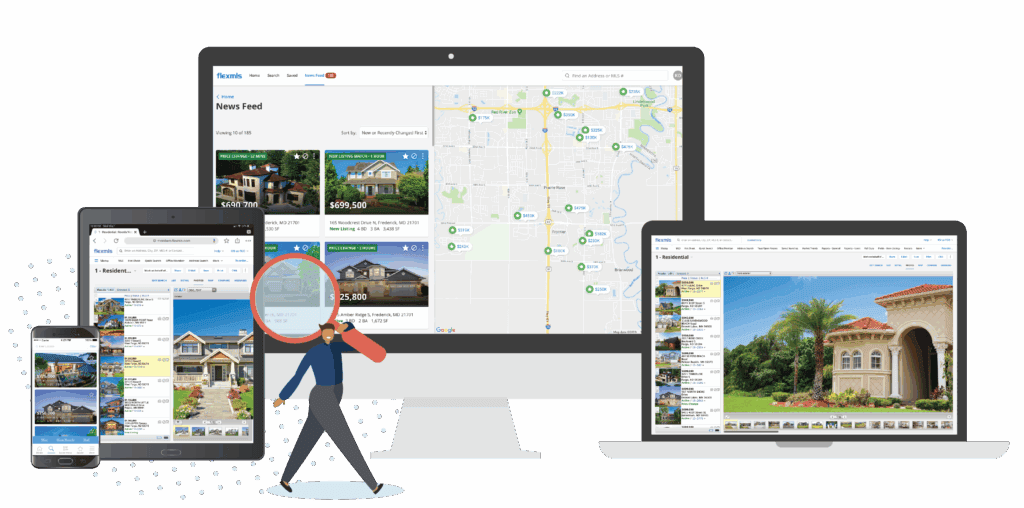The real estate industry thrives on comparison. Buyers, investors, and agents need tools that allow them to evaluate multiple listings side-by-side with precision and efficiency. Enter split-screen MLS views—a breakthrough in property comparison technology. This article explores how split-screen interfaces are transforming the property search experience.
Overview
Split-screen MLS views allow users to compare multiple properties simultaneously, enabling more informed decisions and faster transaction timelines. We’ll examine their role across real estate development, private networks, remote work, AI, analytics, and user experience.
Real Estate Development World
Developers utilize split-screen views to compare land parcels, zoning data, and environmental impact side by side. This reduces decision-making time and enhances strategic planning when investing in new developments.
Private Real Estate Networks
Within exclusive broker networks, split-screen functionality empowers agents to show premium listings next to public market properties, highlighting differences in features, location, and price for qualified buyers.
Remote Real Estate Work
Remote agents use split-screen MLS tools to share live property comparisons during virtual client meetings. This collaborative experience replicates in-person showings and builds trust remotely.
The MLS Concept
MLS (Multiple Listing Service) is a centralized database for real estate listings. Integrating split-screen comparison functionality into MLS enhances usability, especially for power users juggling multiple clients and property types.
Needed Training Courses
Training on comparison techniques, interpreting valuation metrics, and using digital tools ensures agents maximize split-screen features. Courses in UI navigation and CRM integration are essential.
Needed Certifications
Certifications like the Real Estate Technology Specialist (RETS) credential can help agents use MLS platforms with advanced features, including split-screen comparison tools, more effectively.
Onboarding Programs for New Agents
New agents benefit from onboarding modules that demonstrate how to use split-screen tools to highlight key differentiators in listings. Role-play exercises simulate real buyer presentations.
MLS Agent Onboarding Processes
Agent onboarding for MLS systems now includes training on viewing and customizing split-screen layouts. This ensures a faster ramp-up and better service to clients.
MLS Platforms
Modern MLS platforms like Cloud MLX and Flexmls are adopting split-screen tools. These systems allow real-time listing comparisons based on customizable parameters such as school zones, walkability, and energy efficiency.
Optimizing MLS
Optimization strategies include streamlining load times for comparison interfaces, integrating AI tools for automated insights, and enabling drag-and-drop comparisons. These features boost user efficiency.
Artificial Intelligence
AI enhances split-screen tools by providing automated suggestions based on buyer preferences. AI-driven overlays highlight critical differentiators—price per square foot, neighborhood trends, and feature scores.
AI Matching Buyers with Ideal Neighborhoods
AI can compare neighborhood data in split-screen format, enabling users to evaluate school rankings, crime statistics, and demographic trends side by side. This guides better area selection.
Analytics – Economic Impact
Split-screen comparison data can be tracked and analyzed to understand buyer preferences and behaviors. These insights drive more targeted marketing and economic forecasting in the real estate sector.
Data Quality Management
Accurate, clean data is vital for effective comparisons. MLS platforms must maintain high standards for listing input, validating metrics like lot size, price, and amenities for consistent comparison.
Intelligent Listing Alerts Based on Market Movement
When prices drop or status changes, smart alerts suggest updating the user’s split-screen comparison set. This keeps buyer evaluations current and competitive.
Data Security Standards
Secure MLS platforms ensure that client-specific saved comparisons are encrypted. Multi-user permission settings safeguard sensitive property evaluations, especially in investment scenarios.
Sustainable Development Data
Split-screen tools can display sustainability ratings, green certifications, and utility cost comparisons, empowering eco-conscious buyers to make greener choices.
Personalization Features
Users can customize what metrics to compare—interior square footage, garage size, HOA fees, etc., allowing each buyer to focus on what matters most in their decision process.
User Experience Design
Great UI design in split-screen views includes sticky headers, synchronized scrolling, responsive layout, and collapsible sections for deep dives into property specs.
Usability Testing
Platforms regularly conduct usability testing to refine how information is displayed. Focus groups provide feedback on layout intuitiveness, interaction flows, and mobile responsiveness.
Fix and Flip
Investors use split-screen views to compare ARVs (after-repair values), renovation needs, and neighborhood comps. This helps prioritize flips with the highest ROI.
Property Valuation Tools
Integrated AVMs and CMA tools can appear in the comparison layout, offering instant value assessments. This helps users understand pricing trends at a glance.
MLS Tools for First-Time Homebuyers
First-time buyers benefit from simplified comparison templates, highlighting mortgage estimates, commute times, and energy costs. Visual cues help demystify complex decisions.

Split-Screen MLS Views for Property Comparisons
This feature is a game-changer. It:
- Displays 2–4 listings side-by-side
- Syncs scrolling for image and detail alignment
- Highlights price, square footage, and unique features
- Allows live collaboration with clients
- Integrates maps and school ratings
Buyers and agents save time, make better decisions, and gain confidence when comparing options.
Cross-Promotion Strategies in MLS
Agents can use split-screen views during webinars or virtual tours to promote multiple listings simultaneously, increasing exposure and cross-selling opportunities.
Avoiding Legal Trouble When Wholesaling Properties
Split-screen views can be used to ensure transparency by showing wholesale buyers clear comparisons to market-rate listings. This reduces misinformation and potential legal issues.
Leads – Integrating Digital Marketing
Integrated dashboards show ad performance and compare listings clicked through ads. Split-screen views in lead-nurturing platforms allow a better understanding of what properties interest prospects most.
Machine Learning Models
ML analyzes which features users compare most, personalizing future comparisons and offering predictive insights on price changes and buyer intent.
Renewable Energy Integration
Listings with solar panels, energy-efficient HVAC, or green roofs can be tagged. Split-screen comparisons highlight these eco-friendly differences for interested buyers.
Process Improvement
Agents and brokers use comparison analytics to refine workflows—knowing which listings get dropped from comparisons can inform staging, pricing, and marketing improvements.
Innovation Hubs
MLS vendors collaborate with proptech startups in innovation hubs to refine split-screen experiences using AR, smart glasses, or voice control for hands-free comparisons.
Review and Reputation Systems
Comparisons can now include reviews of buildings, HOAs, and neighborhoods. Users can view side-by-side customer satisfaction scores and testimonials.
Venture Capital Investments
VCs are funding startups that specialize in visual comparison tools, signaling strong market interest in enhancing MLS interactivity and usability.
Business Model Innovation
Freemium and SaaS MLS platforms offer basic split-screen tools for free, with advanced features (like live collaboration or AI scoring) available via subscription.
Market Trend Predictive Modeling
Dashboards analyze split-screen usage trends to model emerging market preferences, such as the rising value of remote work amenities or low-energy homes.
Operational Efficiency Solutions
Comparing listings within one window reduces switching, copy-pasting, and note-taking. This improves client servicing time and operational efficiency.
Professional Development
Continuing education courses increasingly include modules on digital comparison tools. Staying current ensures agents remain competitive in tech-savvy markets.
Frequently Asked Questions
What is a split-screen MLS view?
It’s a feature that lets users view and compare multiple listings side-by-side in a single interface.
Who benefits from this feature?
Buyers, agents, investors, and developers who need to evaluate multiple properties efficiently.
Can comparisons be customized?
Yes. Users can choose what features to display, such as price, square footage, or nearby amenities.
Is it available on mobile devices?
Most modern MLS platforms now offer mobile-friendly or app-based split-screen functionality.
Is split-screen view available for off-market listings?
It depends on the platform and permissions within private real estate networks.
Split-screen MLS views are reshaping how property decisions are made. From new agents to seasoned developers, this tool empowers users with visual clarity, interactivity, and deeper insights. As real estate tech continues to evolve, split-screen comparisons will become not just a feature but a standard in every effective MLS platform. Now more than ever, smart comparison tools are the key to smarter real estate decisions.










